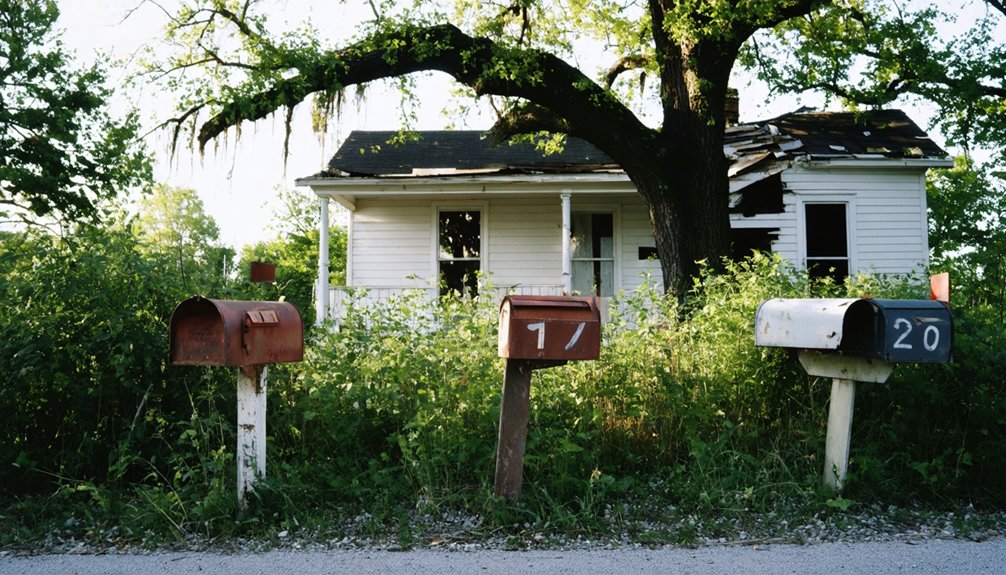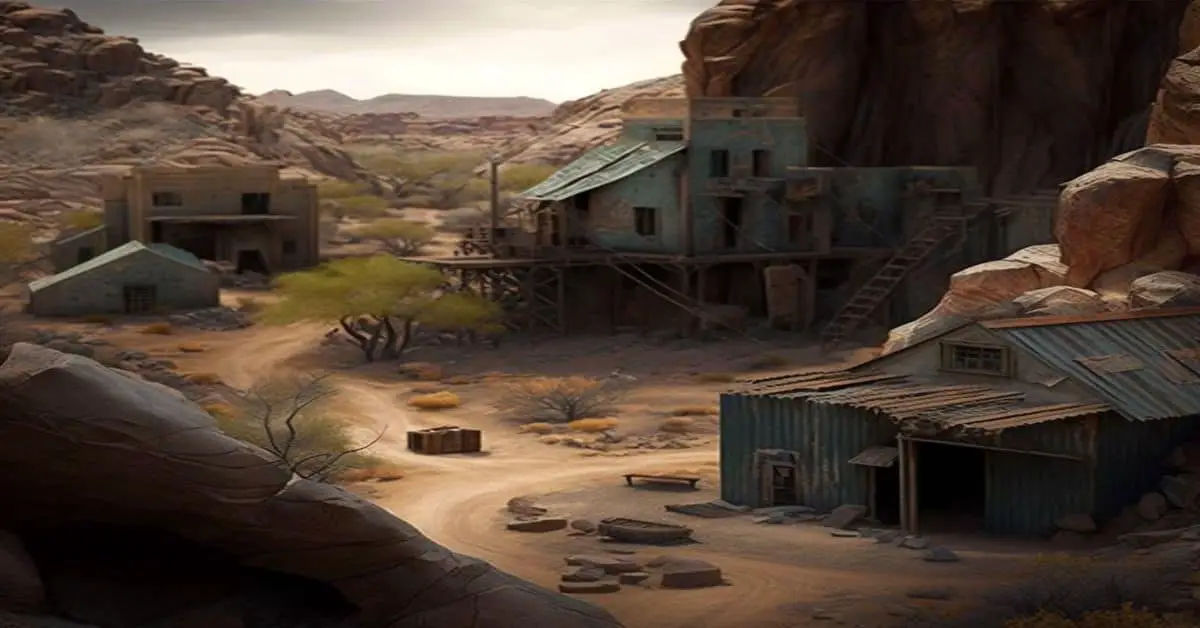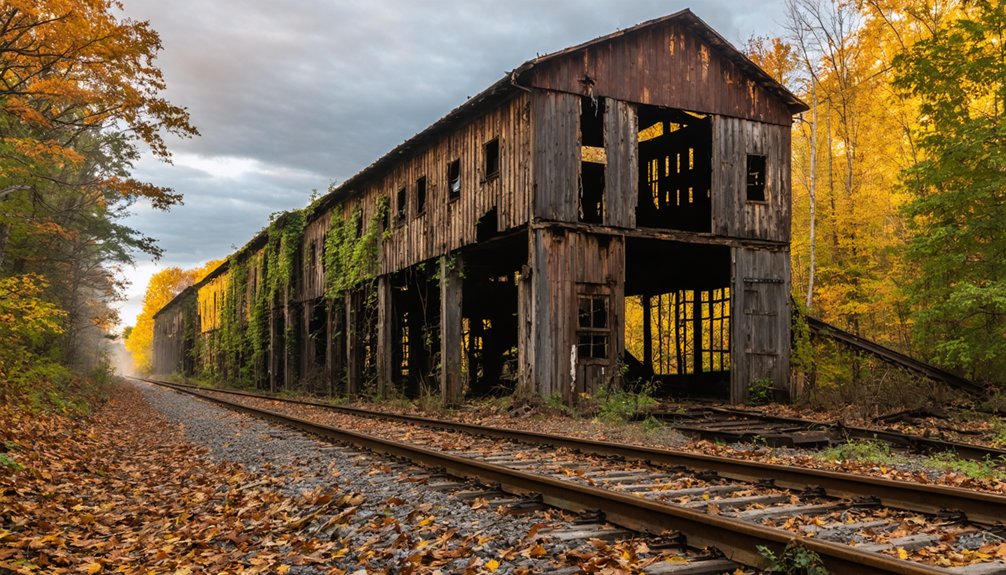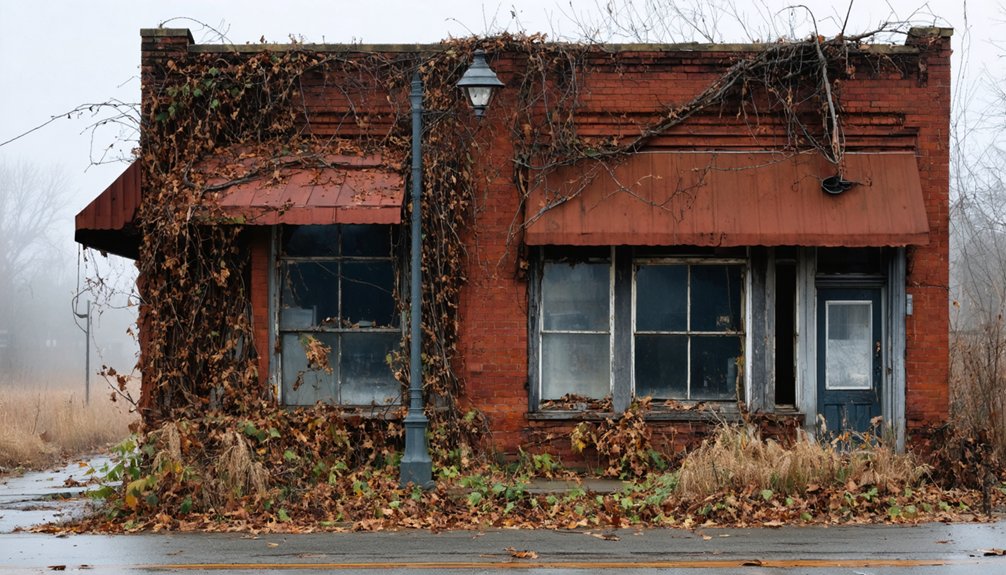You’ll find Collins, Indiana, established in 1872 along the Detroit, Eel River and Illinois Railroad, between Denver and Auburn. Named after railroad official James Collins, this small settlement featured a general store, post office, and mint mill during its peak in the 1870s. While often mistaken for a ghost town after its post office closed in 1913, Collins maintains a modest population today. Its historic buildings and railroad legacy tell a fascinating story of rural American perseverance.
Key Takeaways
- Collins experienced significant decline after its railroad peak in the 1870s, with its post office closing in 1913 and population never exceeding 100.
- While often considered abandoned, Collins maintains a small population and isn’t completely deserted like typical Indiana ghost towns.
- The town’s historic schoolhouse, built in 1877 and restored in 1966, stands as a National Register of Historic Places site.
- Visitors must obtain private property permission to explore Collins’ remaining structures, including abandoned buildings from its railroad era.
- The town lost its economic importance after the railroad’s decline, but retains a quiet farming community amid its historic remnants.
The Birth of a Railroad Town (1872)
As the Detroit, Eel River and Illinois Railroad expanded its network in 1872, the town of Collins emerged along the newly constructed rail line between Denver and Auburn, Indiana.
The town’s strategic location made it an ideal hub for railroad operations, leading to its official platting that same year. The development came after earlier failed attempts by Toledo, Logansport and Northern Rail Road in 1856. You’ll find that railroad infrastructure shaped every aspect of the town’s initial design and purpose.
Collins’ prime location drove its development as a railroad hub, with every element of its design centered around railway operations.
Similar to Collins O. Bright who served his nation through diplomacy, James Collins played a vital role in developing transportation networks. Named after railroad official James Collins, the settlement quickly established its economic significance with the opening of a post office in 1872.
The town’s layout catered specifically to railroad workers and support services, positioning Collins as a crucial stop along the expanding Butler Branch line.
Namesake: James Collins and the Railroad Legacy
James Collins, a railroad official whose influence shaped the early development of Collins, Indiana, left his most visible mark when the town adopted his name in 1872.
You’ll find his legacy intertwined with the Vandalia Railroad’s essential role in establishing the town as an agricultural shipping hub, particularly for onion distribution. Due to the multiple meanings associated with the Collins name, historical records often require disambiguation pages to distinguish between different individuals and places bearing this surname.
While specific biographical details about James Collins remain sparse, his connection to the railroad’s expansion through Indiana solidified the common practice of naming new railroad towns after influential company officials.
Railroad Pioneer’s Lasting Impact
While little biographical information survives about railroad official James Collins, his lasting impact on Whitley County, Indiana endures through the small community that bears his name.
His connection to railroad innovation shaped Collins during the railroad boom of 1872, establishing a crucial transportation hub that transformed local commerce and community growth. Today, researchers can explore Collins’ legacy through historical records on FamilySearch.org.
You’ll find Collins’ pioneering influence reflected in these key developments:
- The Vandalia Railroad’s strategic placement enabled large-scale onion exports to national markets.
- Rail infrastructure attracted settlers and entrepreneurs who established essential businesses.
- The town’s layout and development patterns directly followed railroad expansion principles.
- Early industrial growth, including peppermint milling, flourished due to newfound rail connectivity.
Though Collins may have faded as a commercial center, its founding story exemplifies how railroad pioneers shaped Indiana’s rural landscape.
Town Naming Origins Revealed
The naming of Collins stems from a pivotal railroad employee, James Collins, who shaped the town’s establishment in 1872. You’ll find that this naming choice reflects a common practice of the era, when communities often honored railroad personnel who influenced local development.
The town’s identity became firmly rooted in its railroad heritage when planners formalized the layout and opened a post office that same year. While details about James Collins’ specific role remain limited, his historical significance lives on through the town’s name. The community’s agricultural prominence grew through the Vandalia Railroad, which transported locally grown crops to market.
You can trace this connection to the broader pattern of 19th-century development, where railroad expansion drove settlement and commerce throughout rural Indiana, creating lasting legacies in communities like Collins. The area’s transportation history includes the historic Edna Collins Bridge, constructed in 1922 over Little Walnut Creek.
The Rise and Decline of a Small Community
You’ll find Collins’ initial growth was closely tied to the railroad’s golden age of the 1870s, when the Vandalia line brought new opportunities for shipping agricultural products, particularly onions, across the nation.
The town’s economic peak featured a bustling general store, post office, and mint mill, though the population never exceeded 100 residents. Collins eventually declined when changing economies led to its isolation from major transportation routes. Like many historic Indiana properties, visitors must obtain private property permission before exploring any remaining structures.
Railroad’s Golden Years
During the late 19th century, Collins emerged as a notable railroad hub in Starke County, Indiana, where the Chicago and Atlantic Railroad established essential connections through the region. The railroad infrastructure transformed this small community into a significant transportation nexus, linking local industries to broader markets. These improvements marked a stark contrast to the era when travelers struggled through ill-constructed corduroy roads. By the 1890s, the rise of horse-drawn streetcars marked the beginning of more diverse transportation options in the region.
You’ll find Collins’s golden era of rail transport marked by these significant developments:
- Construction of a strategic spur line from Bass Station to Bass Lake for ice hauling
- Integration into the Monon Route, connecting Louisville, New Albany, and Chicago
- Introduction of both steam and interurban electric railroads by early 1900s
- Development of passenger services to recreational destinations like Bass Lake
The community connections forged through these rail networks positioned Collins as a modest but important transfer point for freight and passengers, supporting regional economic growth through national market access.
Small Town’s Slow Fade
While railroad prosperity brought Collins temporary growth, this small Indiana settlement’s trajectory would mirror many rural American towns of its era.
You’ll find the first signs of decline emerged when the post office closed in 1913, marking a turning point in the community’s liveliness. Despite its agricultural legacy as a major onion producer and mint processor, Collins couldn’t sustain its economic base as markets evolved and farming practices changed.
Yet, you’ll discover a story of quiet community resilience in Collins’ continued existence. Though often mistakenly labeled a ghost town, the settlement maintained a small but steady population.
Its abandoned school and general store tell the tale of gradual transformation rather than complete desertion, while aging buildings stand as evidence to an era when Collins played a crucial role in Indiana’s agricultural landscape.
Historic Buildings and Lost Landmarks
The heart of Collins’ architectural heritage once centered around several key institutional and commercial structures that defined this former railroad town.
You’ll discover a community legacy marked by abandoned buildings that tell the story of this once-thriving settlement. The town’s architectural footprint included:
- A historic schoolhouse that served as the educational center before falling into disuse
- The General Store, which functioned as both a commercial hub and social gathering point
- A specialized mint mill that processed the area’s distinctive peppermint crops
- The Vandalia Railroad infrastructure, complete with loading docks and warehouses
From 1872 to 1913, the post office anchored civic life before its discontinuation.
Unlike some preserved Indiana ghost towns, Collins’ physical structures have largely disappeared, leaving behind only traces of its agricultural and industrial past.
Life Along the Railroad: Commerce and Trade
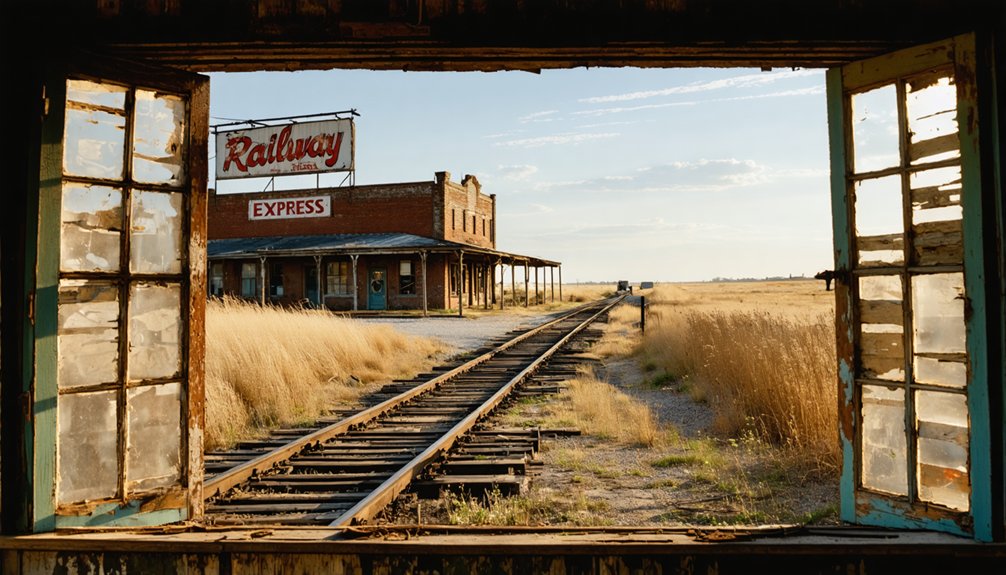
As rail service expanded through Indiana in 1872, Collins emerged as an essential agricultural shipping hub along the Vandalia Railroad line, where farmers transported tons of onions and processed peppermint to markets nationwide.
You’d find railroad connections fueling the town’s growth, as the general store served both locals and travelers while functioning as a crucial supply depot.
The agricultural legacy thrived through a symbiotic relationship between farmers, processors, and rail shipping that created efficient supply chains for both imports and exports.
As transportation evolved beyond rail in the early 1900s, Collins’ commercial importance began to fade.
The closing of the post office in 1913 marked a turning point, signaling the town’s gradual shift toward its eventual ghost town status.
The Post Office Era and Communication Hub
You’ll find evidence of Collins’ community growth in its post office, which was established alongside the town’s founding and served as an essential communication hub for both local residents and commercial enterprises.
The facility handled incoming and outgoing mail while functioning as an informal gathering spot where residents could exchange news and information.
After decades of connecting the rural community to wider postal networks, the Collins post office closed its doors in 1913, marking the end of an era in the town’s history.
Early Mail Service Operations
During the late nineteenth century, mail service operations in Collins began with the establishment of its post office in 1872, marking an essential development in the town’s communication infrastructure.
You’ll find that this rural connectivity hub operated actively for over four decades, providing indispensable services until 1913.
The post office’s key functions included:
- Processing incoming and outgoing correspondence through regional postal networks
- Distributing newspapers, personal letters, and official government notices
- Handling money orders and business transactions for local residents
- Supporting rural free delivery to surrounding farms and settlements
The postmaster managed daily operations from a centrally located building, where they sorted mail and provided direct customer service.
This mail service proved critical for connecting Collins’ residents to opportunities beyond their immediate area.
Postal Communication Hub Impact
The Collins post office served as more than just a mail processing center – it became the heartbeat of local communication from 1872 to 1913. As part of a broader postal network, it connected Collins to surrounding townships while strengthening community ties through daily interactions at this central gathering spot.
You’ll find that the post office’s influence extended beyond mail delivery. It attracted businesses, spurred infrastructure development like improved roads, and served as the primary channel for government notices and business correspondence.
The facility’s staff often acted as local liaisons, helping integrate various community services. When Rural Free Delivery emerged after 1902, it marked the beginning of changes that would lead to the office’s closure in 1913.
This closure weakened local connections and contributed to the town’s eventual decline.
Educational Heritage: The Old Schoolhouse

Standing proudly since 1877, Collins Schoolhouse served as a cornerstone of rural education in Steuben County for over six decades before closing its doors in 1943.
For 66 years, Collins Schoolhouse nurtured young minds, standing as a beacon of rural education in Steuben County.
This one-room brick schoolhouse, built in Italianate style, replaced an earlier log structure and provided countless educational experiences for local children.
You’ll find the schoolhouse’s rich heritage preserved through:
- The original bell still housed in its square-plan belfry
- Many authentic features from its operational period
- The steep gable roof and traditional brick construction
- The single-room layout typical of rural education
Thanks to strong community involvement, June Collins purchased the building in 1947, and former students helped restore it in 1966-1967.
Today, you can visit this National Register of Historic Places site during summer Sundays or by special arrangement.
Myths vs. Reality: Not Quite a Ghost Town
While Collins Schoolhouse represents a preserved piece of local history, modern-day Collins challenges common misconceptions about what constitutes a true ghost town.
You’ll find that unlike authentic ghost towns such as Hindostan, where disease led to complete abandonment, Collins history tells a different story. The town maintains a small but persistent population, with several occupied homes defying the ghost town label.
You won’t find a dramatic tale of sudden exodus or catastrophe here. Instead, Collins’ transformation reflects a gradual decline tied to broader rural changes in Indiana.
While abandoned buildings and minimal economic activity might suggest desertion, the community’s resilience is evident in its continued habitation. This makes Collins distinctly different from Indiana’s documented ghost towns, where complete abandonment defines their status.
Surviving Structures and Current Landscape
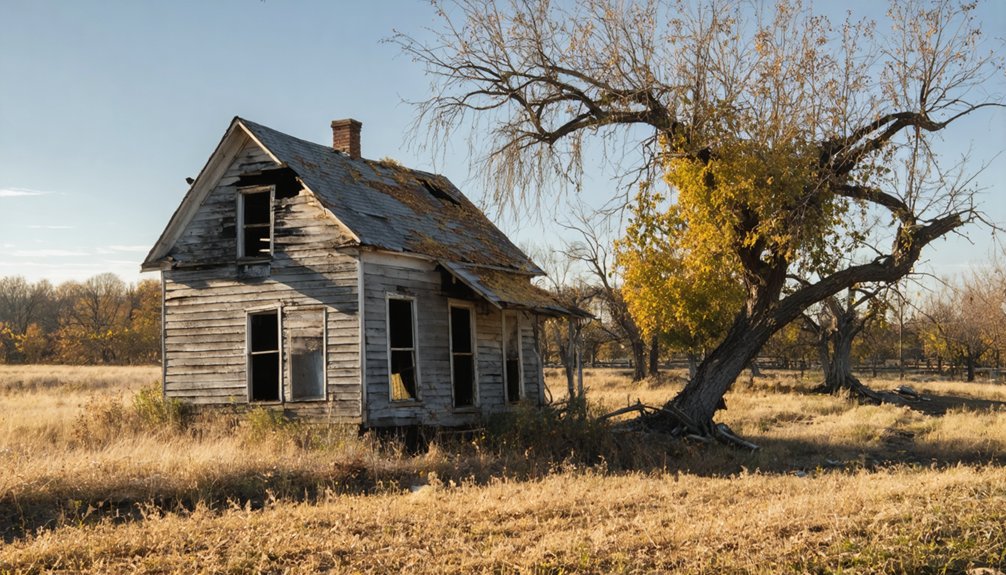
Among Collins’ surviving structures, a late-1800s Victorian mansion stands as the town’s most impressive architectural remnant, featuring soaring 14-foot ceilings and nine-panel bifold doors that speak to its merchant-class origins.
The mansion’s architectural significance is evident in its intricate fireplaces and masterful staircase craftsmanship.
While nature reclaims much of Collins’ landscape, you’ll find:
- Scattered concrete foundations marking former business locations
- A rusted railroad sign near the old depot site
- Overgrown pathways where streets once connected the community
- The Victorian house requiring urgent roof repairs for preservation
The surrounding farmland has largely overtaken Collins’ original footprint, with preservation challenges mounting as time passes.
Most commercial and public buildings have vanished, leaving only traces of the town’s vibrant past.
Collins Today: A Quiet Rural Settlement
Today’s Collins bears little resemblance to its once-bustling past, existing now as a sparsely populated rural settlement in Smith Township, Whitley County.
While some might mistake it for a ghost town, you’ll find scattered residences where families embrace the quiet life amid Indiana’s farmland.
You won’t find stores or public services here anymore – the last post office closed in 1913.
Instead, residents rely on nearby towns and Columbia City for their daily needs.
The community’s rural charm persists through its pastoral landscape of farms and modest homes connected by local roads.
Despite Whitley County’s slow but steady growth, Collins maintains its understated character, representing a slice of authentic rural Indiana where people choose a simpler, less commercial way of living.
Frequently Asked Questions
What Natural Disasters or Significant Events Affected Collins Throughout Its History?
You’ll find regional flooding impacts and fire disasters affected nearby towns, though there’s no direct evidence of specific catastrophic events in Collins beyond typical Southern Indiana environmental challenges.
Are There Any Notable People or Celebrities Who Originated From Collins?
Like footprints in untouched snow, notable residents are absent from Collins’ history. You won’t find any celebrities or widely recognized figures, though local legends mainly center around railroad worker James Collins.
What Were the Peak Population Numbers During Collins’ Most Prosperous Years?
You won’t find exact ghost town demographics, but historical evidence suggests Collins’ peak population likely reached the low hundreds during its prosperous 1870s-1900s period before population decline began around 1913.
Did Collins Have Any Churches or Religious Establishments in Its Early Days?
Let’s cut to the chase – you can’t find any solid evidence of church history or religious significance in Collins. Historical records don’t show a single established church during its 1872-1913 active period.
What Native American Tribes Originally Inhabited the Area Before Collins Was Established?
You’ll find that the Miami people and their Wea band dominated this region’s native tribes and cultural heritage, while Potawatomi, Piankeshaw, and occasional Shawnee settlements also shaped the area’s indigenous landscape.
References
- https://www.heraldtimesonline.com/story/lifestyle/home-garden/2020/05/01/ghost-towns-in-ohio-and-indiana/43807535/
- https://www.youtube.com/watch?v=45D4dbASJyE
- https://www.houseofhighways.com/usa/midwest/indiana/collins
- http://freepages.rootsweb.com/~gtusa/history/usa/in.htm
- https://en.wikipedia-on-ipfs.org/wiki/Collins
- https://kids.kiddle.co/Collins
- https://www.onlyinyourstate.com/experiences/indiana/ghost-towns-in
- https://goputnam.com/things-to-do/edna-collins-bridge/
- https://en.wikipedia.org/wiki/Butler_Branch_(Indiana)
- https://www.wikiwand.com/en/articles/Collins
